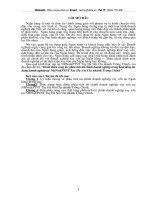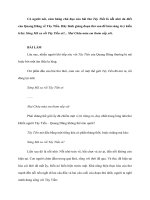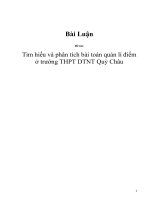Phân tích bài đọc trong toiec 9 docx
Bạn đang xem bản rút gọn của tài liệu. Xem và tải ngay bản đầy đủ của tài liệu tại đây (41.67 KB, 6 trang )
men and women ?
(A) Clearing fields
(B) Planting corn
(C) Harvesting corn
(A) Harvesting squash
8. The word "disaster" in line 22 is closest in meaning to
(A) control
(B) catastrophe
(C) avoidance
(A) history
9. According to the passage, the Mandans preserved their food by
(A) smoking
(B) drying
(C) freezing
(A) salting
10. The word "it" in line 25 refers to
(A) June
(B) corn
(C) time
(A) squash
11. Which of the following crops was cultivated primarily by men ?
(A) Corn
(B) Squash
(C) Sunflower
(A) Tobacco
12. Throughout the passage, the author implies that the Mandans
(A) planned for the future
(B) valued individuality
(C) were open to strangers
(A) were very adventurous
Questions 13-21
The elements other than hydrogen and helium exist in such small quantities that it is
accurate to say that the universe is somewhat more than 25 percent helium by weight
and somewhat less than 75 percent hydrogen.
Line Astronomers have measured the abundance of helium throughout our galaxy and in
(5) other galaxies as well. Helium has been found in old stars, in relatively young ones, in
interstellar gas, and in the distant objects known as quasars. Helium nuclei have also
been found to be constituents of cosmic rays that fall on the earth (cosmic "rays" are
not really a form of radiation; they consist of rapidly moving particles of numerous
different kinds). It doesn't seem to make very much difference where the helium is
(10) found. Its relative abundance never seems to vary much. In some places, there may be
slightly more of it ; in others, slightly less, but the ratio of helium to hydrogen nuclei
always remains about the same.
Helium is created in stars. In fact, nuclear reactions that convert hydrogen to helium
are responsible for most of the energy that stars produce. However, the amount of
(15) helium that could have been produced in this manner can be calculated, and it turns out
to be no more than a few percent. The universe has not existed long enough for this
figure to be significantly greater. Consequently, if the universe is somewhat more than
25 percent helium now, then it must have been about 25 percent helium at a time near
the beginning.
(20) However, when the universe was less than one minute old, no helium could have
existed. Calculations indicate that before this time temperatures were too high and
particles of matter were moving around much too rapidly. It was only after the one-
minute point that helium could exist. By this time, the universe had cooled so
sufficiently
that neutrons and protons could stick together. But the nuclear reactions that led to the
(25) formations of helium went on for only relatively short time. By the time the universe
was a few minutes old, helium production had effectively ceased.
13. What does the passage mainly explain ?
(A) How stars produce energy
(B) The difference between helium and hydrogen
(C) When most of the helium in the universe was formed
(D) Why hydrogen is abundant
14. According to the passage, helium is
(A) the second-most abundant element in the universe
(B) difficult to detect
(C) the oldest element in the universe
(D) the most prevalent element in quasars
15. The word "constituents" in line 7 is closest in meaning to
(A) relatives (B) causes
(C) components (A) targets
16. Why does the author mention "cosmic rays" in line 7 ?
(A) As part of a list of things containing helium
(B) As an example of an unsolved astronomical puzzle
(C) To explain how the universe began
(A) To explain the abundance of hydrogen in the universe
17. The word "vary" in line 10 is closest in meaning to
(A) mean
(B) stretch
(C) change
(A) include
18. The creation of helium within stars
(A) cannot be measured
(B) produces energy
(C) produces hydrogen as a by-product
(A) causes helium to be much more abundant in old stars
than in young stars
19. The word "calculated" in line 15 is closest in meaning to
(A) ignored
(B) converted
(C) increased
(A) determined
20. Most of th helium in the universe was formed
(A) in interstellar space
(B) in a very short time
(C) during the first minute of the universe's existence
(A) before most of the hydrogen
21. The word "ceased" in line 26 is closest in meaning to
(A) extended
(B) performed
(C) taken hold
(A) stopped
Questions 22-31
In colonial America, people generally covered their beds with decorative quilts
resembling those of the lands from which the quilters had come. Wealthy and socially
prominent settlers made quilts of the English style, cut from large lengths of cloth of
Line the same color and texture rather than stitched together from smaller pieces. They made
(5) these until the advent of the Revolutionary War in 1775, when everything English
came to be frowned upon.
Among the whole-cloth quilts made by these wealthy settlers during the early period
are those now called linsey-woolseys. This term was usually applied to a fabric of wool
and linen used in heavy clothing and quilted petticoats worn in the wintertime. Despite
(10) the name, linsey-woolsey bedcovers did not often contain linen. Rather, they were
made of a top layer of woolen or glazed worsted wool fabric, consisting of smooth,
compact yarn from long wool fibers, dyed dark blue, green, or brown, with a bottom
layer of a coarser woolen material, either natural or a shade of yellow. The filling was
a soft layer of wool which had been cleaned and separated and the three layers were
(15) held together with decorative stitching done with homespun linen thread. Later, cotton
thread was used for this purpose. The design of the stitching was often a simple one
composed of interlocking circles or crossed diagonal lines giving a diamond pattern.
This type of heavy, warm, quilted bedcover was so large that it hung to the floor.
The corners were cut out at the foot of the cover so that the quilt fit snugly around the
tall
(20) four-poster beds of the 1700's, which differed from those of today in that they were
shorter and wider ; they were short because people slept in a semi-sitting position with
many bolsters and pillows, and wide because each bed often slept three or more. The
linsey-woolsey covering was found in the colder regions of the country because of the
warmth it afforded. There was no central heating and most bedrooms did not have
fireplaces.
22. What does this passage mainly discuss ?
(A) The processing of wool
(B) Linsey-woolsey bedcovers
(C) Sleeping habits of colonial Americans
(A) Quilts made in England
23. The word "prominent" in line 3 is closest in meaning to
(A) isolated
(B) concerned
(C) generous
(A) distinguished
24. The author mentions the Revolutionary War as a time period when
(A) quilts were supplied to the army
(B) more immigrants arrived from England
(C) quilts imported from England became harder to find
(A) people's attitude toward England changed
25. The phrase "applied to" in line 8 is closest in meaning to
(A) sewn onto
(B) compared to
(C) used for
(D) written down on
26. The term "linsey-woolsey" originally meant fabric used primarily in
(A) quilts
(B) sheets
(C) clothing
(D) pillows
27. The word "coarser" in line 13 is closest in meaning to
(A) older
(B) less heavy
(C) more attractive
(D) rougher
28. The quilts described in the second and third paragraphs
were made primarily of
(A) wool
(B) linen
(C) cotton
(D) a mixture of fabrics
29. It can be inferred from the third paragraph that the sleeping habits of most
Americans have changed since the 1700's in all of the following ways EXCEPT
(A) the position in which people sleep
(B) the numbers of bolsters or pillows people sleep on
(C) the length of time people sleep
(D) the number of people who sleep in one bed
30. The word "afforded" in line 24 is closest in meaning to
(A) provided
(B) spent
(C) avoided
(D) absorbed
31. Which of the following was most likely to be found in a bedroom in
the colder areas of the American colonies ?
(A) A linsey-woolsey
(B) A vent from a central heating system
(C) A fireplace
(D) A wood stove
Questions 32-41
Growing tightly packed together and collectively weaving a dense canopy of
branches, a stand of red alder trees can totally dominate a site to the exclusion of
almost everything else. Certain species such as salmonberry and sword ferns have
Line adapted to the limited sunlight dappling through the canopy, but few evergreen trees
(5) will survive there; still fewer can compete with the early prodigious growth of alders.
A Douglas fir tree reaches its maximum rate of growth ten years later than an alder,
and if two of them begin life at the same time, the alder quickly outgrows and
dominates the Douglas fir. After an alder canopy has closed, the Douglas fir suffers a
marked decrease in growth, often dying within several years. Even more shade-tolerant
(10) species of trees such as hemlock may remain badly suppressed beneath aggressive
young alders.
Companies engaged in intensive timber cropping naturally take a dim view of alders
suppressing more valuable evergreen trees. But times are changing; a new generation
of foresters seems better prepared to include in their management plans consideration
(15) of the vital ecological role alders play.
Among the alder's valuable ecological contributions is its capacity to fix nitrogen in
nitrogen-deficient soils. Alder roots contain clusters of nitrogen-fixing nodules like
those found on legumes such as beans. In addition, newly developing soils exposed by
recent glacier retreat and planted with alders show that these trees are applying the
(20) equivalent of ten bags of high-nitrogen fertilizer to each hectare per year. Other
chemical changes to soil in which they are growing include a lowering of the base
content and rise in soil acidity, as well as a substantial addition of carbon and calcium
to the soil.
Another important role many alders play in the wild, particularly in mountainous
(25) areas, is to check the rush of water during spring melt. In Japan and elsewhere, the
trees are planted to stabilize soil on steep mountain slopes. Similarly, alders have been
planted to stabilize and rehabilitate waste material left over from old mines, flood
deposits, and landslide areas in both Europe and Asia.
32. What does this passage mainly discuss ?
(A) Differences between alder trees and Douglas fir trees
(B) Alder trees as a source of timber
(C) Management plans for using alder trees to improve soil
(D) The relation of alder trees to their forest environments
33. The word "dense" in line 1 is closest in meaning to
(A) dark
(B) tall
(C) thick
(D) broad
34. Alder trees can suppress the growth of nearby trees by depriving them of
(A) nitrogen
(B) sunlight
(C) soil nutrients
(D) water
35. The passage suggests that Douglas fir trees are
(A) a type of alder
(B) a type of evergreen
(C) similar to sword fern
(D) fast-growing trees
36. It can be inferred from paragraph 1 that hemlock trees









